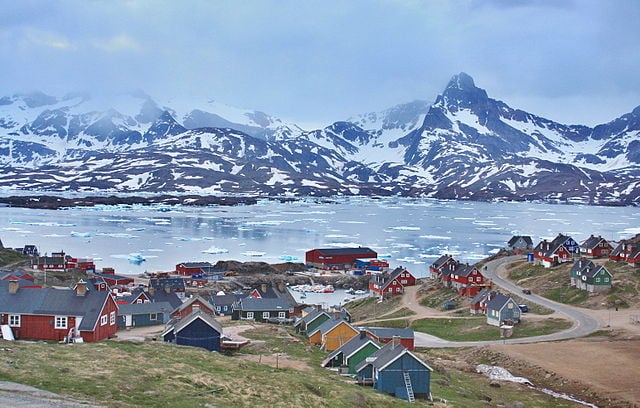Inuktitut: A Language Without an Alphabet
When is an alphabet not, in fact, an alphabet?
Before we have you scratching your heads at us and thinking that perhaps we have lost the plot, we promise; there is in fact a very simple answer to that. An alphabet that isn’t really an alphabet is called an abugida. While these two writing systems are often confused there is actually a marked difference. Where an alphabet has a symbol to represent each of the letters that make up a particular language, an abugida representing a language has only the symbols to represent consonant letters, and the orientation of such symbols determines which vowels are to follow.
Complicated? It doesn’t have to be!
Welcome to the writing system of the intriguing language that is Inuktitut, spoken by some 65,000 people throughout Greenland, Canada, Alaska and Siberia, as well as a few hundred in Russia and the potential for up to 7000 in Denmark.
Origins
Photo via Wikimedia
Inuktitut is an aboriginal language of the furthest reaches of North America, invented by Christian missionaries visiting these remote areas. The Moravian missionaries first attempted this in Greenland and Labrador in the mid nineteenth century using the Latin script, and since then several developments have been made to progress the writing system.
During the 1870s Anglican missionary Edmund Peck promoted the use of Inuktitut across Canadian Arctic, translated the bible into Inuktitut, and also wrote both an Eskimo Grammar and an Eskimo-English Dictionary.
Since 1976 the Language Commission of the Inuit Cultural Institute has approved two standardized writing systems for Inuktitut in Canada: one using the syllabary and the other using the Latin alphabet (qaniujaaqpait – ᖃᓂᐅᔮᖅᐸᐃᑦ).
From the first book printed in Cree script by John Hordon in 1855-56, which was a selection of Gospels written in the dialect of the Inuit of Little Whale River (‘ᒋᓴᓯᑊ ᐅᑲᐤᓯᐣᑭᐟ’, Jesus’ words), to efforts by linguists sent from the Canadian and American governments, Inuktitut is now classified as the Unified Canadian Aboriginal Syllabics under the Unicode standard.
Basics

Photo via Wikimedia
So what letters make up the the Inuktitut abiguda? For consonants we have: g, j, k, l, m, n, p, q, r, s, t, v, ng, ł, or absent, and for vowels a, i, u, ai (now only in Nunavik), or absent. Remember also that these are syllabic sounds rather than individual letters, hence the absence for both consonants and vowels.
And what does it look like? The Inuktitut script – ᑎᑎᕋᐅᓯᖅ ᓄᑕᐊᖅ (titirausiq nutaaq) – is written from left to right in horizontal lines, is commonly presented as a syllabary, and looks something like this:
Prefixes and suffixes are added to root words to expand on more complicated ideas, diacritical marks help a reader understand if the vowel sound is long or short, and superscripted symbols or show how the sound should end.
Learning a new language? Check out our free placement test to see how your level measures up!
ᑎᑎᕋᐅᓯᖅ ᓄᑕᐊᖅ (Inuktitut)
In the spirit of equality post- American election, here is Inuktitut in action so to speak:
Which is of course from Article 1 of the Universal Declaration of Human Rights which states that: All human beings are born free and equal in dignity and rights. They are endowed with reason and conscience and should act towards one another in a spirit of brotherhood.
(Transliteration: Inuluktaat inuulisaannguqput nangminiirungnasimaqaqɬutik ajjigiingmiglu ilitarijaujjutsiaqaqɬutiglu pijungnautitauqaqɬutik. Isumaksaqsiurungnatsiarnirmik inuutsiarutigijarlu piliqtungauttut, asianngurnullu iliurnirviqatigiittaruksariaqaraluaqput qatanngutigiiqqatigiittut anirniqsaarni.)
(Not an) outlier?

Photo via Wikimedia
Perhaps this is the first time you have heard of Inuktitut, or maybe it is even the first time you have heard of an abugida writing system. If that is the case, then you are in for a surprise, for Inuktitut is one of multiple languages that use an abugida system. The full list is:
Ahom, Badaga, Balinese, Batak, Baybayin (Tagalog), Bengali, Bima, Blackfoot, Brahmi, Buhid, Burmese, Carrier, Chakma, Cham, Cree, Dehong Dai, Devanagari, Dives Akuru, Ethiopic, Evēla Akuru, Fraser, Gondi, Grantha, Gujarati, Gupta, Gurmukhi, Rohingya, Hanuno’o, Inuktitut, Javanese, Jenticha, Kaithi, Kannada, Kawi, Kerinci, Kharosthi, Khmer, Khojki, Kulitan, Lampung, Lanna, Lao, Lepcha, Limbu, Lontara/Makasar, Lota Ende, Malayalam, Manpuri, Modi, Mongolian Horizontal Square Script, Mro, New Tai Lue, Ojibwe, Odia, Pahawh Hmong, Pallava, Phags-pa, Ranjana, Redjang, Sasak, Satera Jontal, Shan, Sharda, Siddham, Sindhi, Sinhala, Sorang Sompeng, Sourashtra, Soyombo, Sundanese, Syloti Nagri, Tagbanwa, Takri, Tamil, Telugu, Thai, Tibetan, Tigalari (Tulu), Tikamuli, Tocharian, Tolong Siki, Varang Kshiti.
Inuktitut as one of several Inuit languages shows great variation across the Arctic and indeed wherever it appears in the world. This can be down to political division, different churches reflecting the arrival of different missionaries, and of course plain old-fashioned dialectal difference!
We hope we have opened your eyes to yet another language writing system and that your interest is piqued enough for you to go and investigate some language learning of your own!



